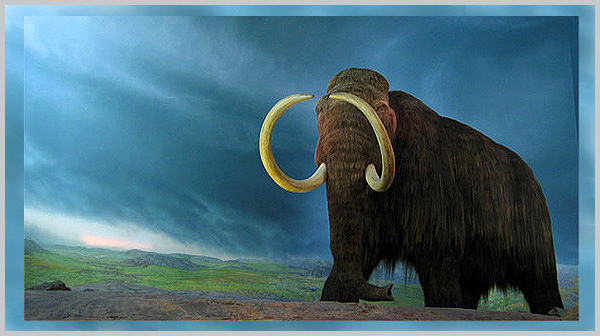
Pleistocene Megafauna
Name: Woolly Mammoth (Mammuthus primigenius)
Conservation Status: Extinct
Fifteen thousand years ago giant animals roamed the North American continent. These extremely large animals, known as megafauna, included several species of elephant, such as the well known woolly mammoth, and sabertooth tigers which were lion-sized cats with knife-like teeth.
There also were larger cousins of animals still present today, such as the giant short-faced bear (Actodus simus) which was 30 percent larger than today’s grizzly bear, and the massive dire wolf (Canis dirus). There were camels, llamas, horses, cheetahs, sloths, and other mammals, both large and small, which no longer exist on this continent.
An extraordinary number of mammals became extinct in North America during what is called the late Pleistocene era, which includes the time before, during, and immediately after the last ice age. Ice ages, when large areas of land are covered by continental glaciers, have occurred repeatedly during the Earth’s history.
The last time glaciers covered large parts of North America was from approximately 132,000 years ago until 10,000 years ago. Changes in climate account for the advance and retreat of the glaciers.
Because the late Pleistocene extinctions occurred so long ago and involved so many species, it is difficult to be accurate about exactly when they occurred, but they seem to have occurred when the glaciers were retreating. Some archaeologists believe that many of the extinctions occurred about 12,000 years ago.
There has been great debate about what caused the extinction of the woolly mammoth. Some people believe that humans, who may have entered North America for the first time about 12,000 years ago, drove the megafauna to extinction by hunting them.
The coincidence in time of the arrival of the first humans and the extinctions of the megafauna forms the basic evidence for an anthropogenic explanation of Pleistocene extinctions.
Known as the “Pleistocene overkill hypothesis,” the scenario involves rapid colonization by big game-hunting humans with large spears who extirpated the megafauna while spreading throughout the continent.
The explanation given in the Pleistocene overkill hypothesis is similar to that of certain bird extinctions on islands, such as the dodo and the moa, which came about as a consequence of colonization by humans. Island biogeography indicates that island species are more vulnerable to extinction than continental species.
The idea that people with such primitive technology and low population numbers could cause so many extinctions in a continental setting is fascinating.
However, there are some serious problems with the evidence on which the Pleistocene overkill hypothesis is based. The idea that the extinctions occurred just when the first humans arrived has not held up very well over the years since the hypothesis was proposed.
There is mounting evidence for much earlier colonization by humans. The animal extinction dates range over a period from 18,500 years ago to 6,500 years ago, and they do not follow the expected pattern of human movement from the point of first entry, Siberia.
Furthermore, only two of the many types of animals that became extinct have ever been associated with human hunting activities. There is clear archaeological evidence for human hunting to be the only cause of the disappearance of mammoths and mastodons, both elephant-like creatures.
Other species that became extinct have not been found in contexts that indicate they were hunted by humans. Other species that clearly were targeted by human hunters, such as bison, lived through the Pleistocene extinction episode and survive today.
Even presuming that these hunters ate nothing but big-game meat, they would have killed at least 10 times more than their dietary needs demanded. This is unlikely, given how dangerous the hunts would have been.
Finally, two often overlooked, but critical pieces of evidence against the overkill hypothesis, are that numerous unhunted bird species also became extinct during this time period. Many smaller mammals underwent drastic reductions in range size as well. Climate change is an alternative explanation of Pleistocene megafauna extinctions that is consistent with this latter evidence.
Questions for Thought:
The debate over the Pleistocene overkill hypothesis continues. One explanation for the lack of archaeological evidence that now-extinct species other than mammoths and mastodons were hunted by humans is that the killing took place so quickly that the sites did not get preserved. Does this make sense to you? Why or why not?
Why are people today inclined to believe the Pleistocene overkill hypothesis without examining the evidence?
Another theory that helps support the Pleistocene overkill hypothesis is that one of the hunted species was a keystone species. In this scenario, humans caused the extinction of mammoths, whose absence then changed the habitat.
This change in habitat structure then brought about the extinction of the other species. What kind of evidence would you need to support this theory? Which other case studies describe keystone species?
Related Classroom Activities
[CS2-8,C3-1,C3-2, General]